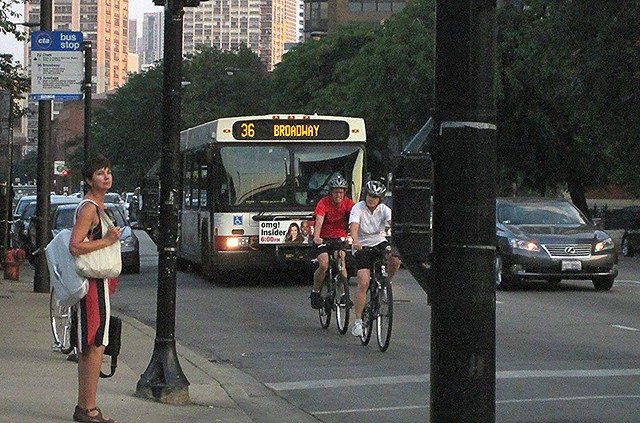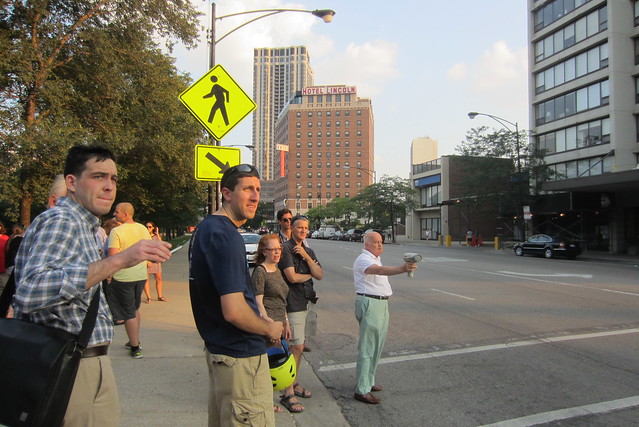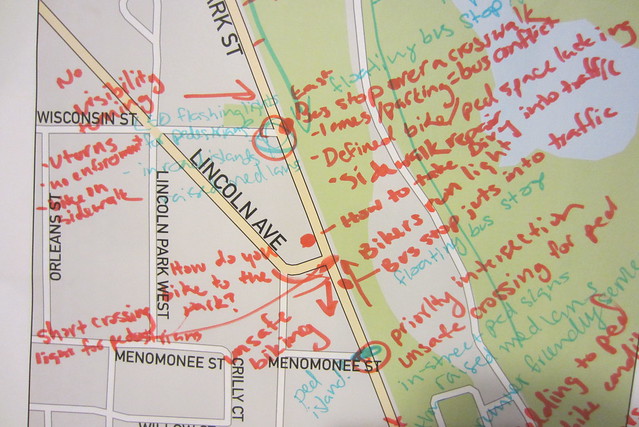When participants at Tuesday night’s Streetside Workshop on how to improve Clark Street from North to Dickens avenues were asked to identify which transportation mode currently dominates Clark, the answer was obvious: cars. The seminar, organized by the grassroots group Bike Walk Lincoln Park, the Active Transportation Alliance, and 43rd Ward Alderman Michele Smith, took place at the intersection of Clark and Menomonee. The goal was to brainstorm ideas for transforming Clark from a wide, intimidating roadway to a complete street that safely accommodates pedestrians, cyclists and transit users, not just drivers.
After a brief introduction from Active Trans Campaign Manager Brenna Conway and Alderman Smith, organizers invited attendees to use a radar gun to capture the speeds of passing motor vehicles. There was some discussion about whether drivers would slow down due to the presence of the 35 participants. Regardless, the highest speed recorded on the street, which has a 30 mph speed limit, was 41 mph. One of the first people the group witnessed attempting to cross got stuck in the middle of the road, since there is no pedestrian refuge island at the intersection, just four lanes of whizzing car traffic.
The hands-on approach continued during the second part of the workshop. In teams of seven, residents, business owners, and other stakeholders focused on one intersection each. They filled out a questionnaire to provide more info about road users’ behavior with questions like “Do cars stop at red lights?” and “Do cars, including turning cars, yield to pedestrians in the crosswalk?” The survey also included questions about the street design, such as “How would you describe the corners of the intersection?” with multiple-choice answers: “Wide corners that allow fast turns,” “Medium corners with some fast turns,” and “Narrow corners for mostly cautious turning.”
Many participants voiced concerns about lack of pedestrian accommodations on Clark, such as the dearth of crosswalks and refuge islands. One community member mentioned that the difficulty of crossing Clark at Menomonee is particularly a problem during the popular Green City Market outdoor farmers market in Lincoln Park. Despite the heavy foot traffic on market days, pedestrians must traverse a space where driving is prioritized.
Buzzwords such as “citizen involvement” or “participatory planning” are sometimes tossed around in transportation planning and advocacy circles to describe all kinds of public meetings, regardless of their usefulness. This was not so at the Streetside Workshop, which featured blurred lines between leaders and participants. The attendees’ own observations served as the main talking points when the meeting continued indoors at the nearby Hotel Lincoln.
Despite the presence of unique conditions at each intersection along this stretch of Clark, the group concluded similar changes need to be made at the different locations. Throughout the corridor, vehicle speeds are too high and pedestrians have low comfort levels. The streetscape is confusing, and pedestrians, bicyclists, transit users and drivers must jockey for the same space, which leads to low rule compliance. One group counted four illegal U-turns by cars and five cyclists on the sidewalk within a half hour.
No matter with which intersection they had observed, all participants seemed to feel that that the current street design benefited no one, even motorists, since they face traffic bottlenecks and unpredictable movements by other road users. Pedestrian crossings feel unsafe and lack consistency since some are merely two parallel lines while others have upgraded to high-visibility, zebra-striped “international” crosswalks. Implementing a road diet that would remove and/or narrow travel lanes on Clark, striping international crosswalks at all intersections, and adding LED lights in the crosswalks were suggested as remedies.
After each group presented its top three concerns about the assigned intersection, Brenna Conway and fellow Active Trans Campaign Manager Jim Merrell moved to discussing so-called “yes ideas,” proposals for what Clark Street could look like in the future. Here are some more of the “yes ideas” brainstormed at the meeting:
Pedestrians
- Build pedestrian refuge islands at the intersections with Menomenee and Wisconsin
- Hire crossing guards for high-foot-traffic days like farmers’ markets and the Air and Water Show
- Add runner-friendly crushed limestone surfaces to the paths that parallel Clark in Lincoln Park
Transit Users
- Convert two of the travel lanes to dedicated bus lanes for bus rapid transit
- Implement bus-priority traffic signals
- Add concrete bus stop islands to facilitate boarding
Bicyclists
- Convert travel lanes to bike lanes, possibly a Dearborn-style two-way protected lanes with bike-specific traffic signals
- Widen Stockton Drive, which runs parallel to Clark through Lincoln Park, to make room for bike lanes
- Divide the sidewalk on the east side of Clark, next to the park, into three lanes: two for cyclists and one for joggers
Other ideas
- Increase traffic law enforcement
- Add planters and landscaping
At the end of the meeting, representatives from the 43rd Ward, Bike Walk Lincoln Park, the Chicago History Museum, the Moody Church, and a local business provided some final thoughts, largely centered around improving conditions for pedestrians. The rep from the museum said that visitors and the elderly routinely experience “derailment” at the convoluted LaSalle Street intersection. The speakers mentioned the need to create a safer, more functional, more pleasant Clark Street, one where removing excess travel lanes and calming traffic will simplify access to local destinations so that businesses can thrive.
The Streetside Workshop provided a snapshot of residents’ desires for the future of Clark Street. If Alderman Smith and the Chicago Department of Transportation heed their constituents’ advice, Clark Street will indeed become a more efficient and vibrant neighborhood route.
Guest contributor Kristen Maddox recently spent a year in Copenhagen as a Fulbright fellow and worked with Copenhagenize Design Company. Now back in the US, she is actively looking for work in bicycle planning and advocacy.








